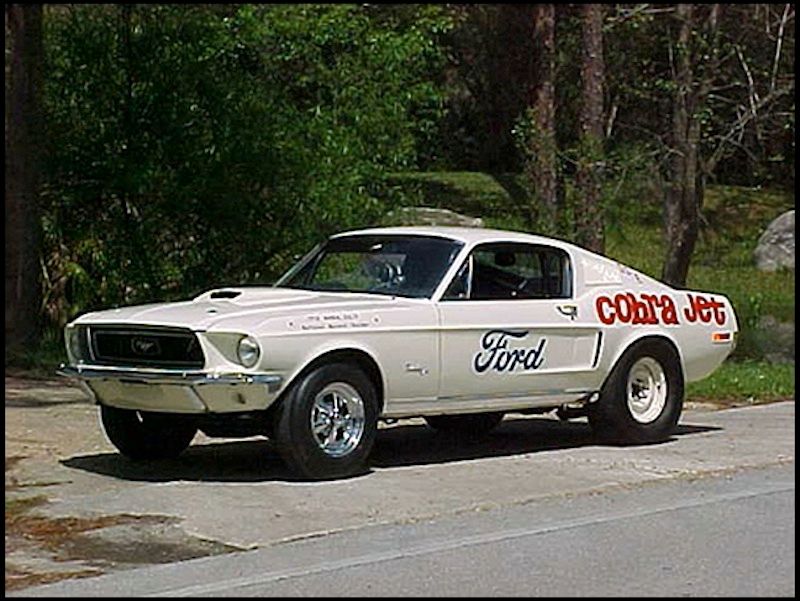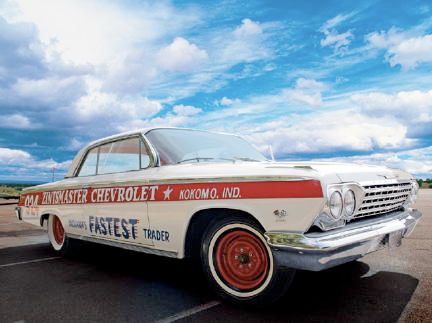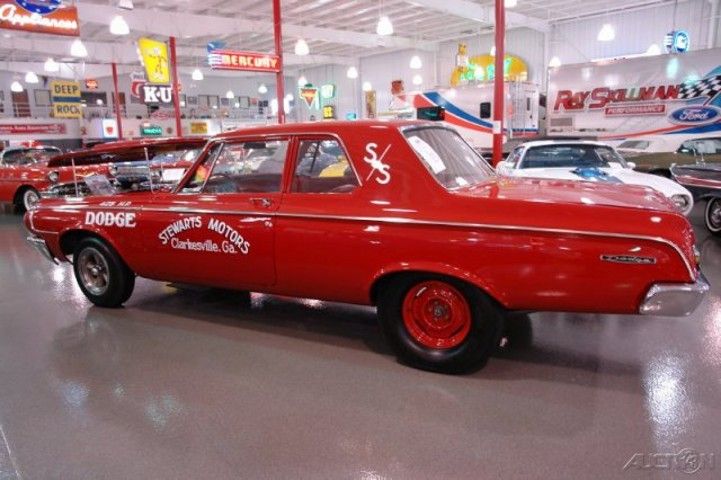Super Stock by John Balich
In the early 1960’s, before the so-called "factory hot rods" as today’s Pro Stock machines are called, the drag world was embroiled in a spiraling performance war between honest-to-goodness specialized drag cars direct from the "big three" auto makers. The folks from Dearborn for one, were fully committed to the Sunday wars, their hottest hardware of the day doing battle with the legendary Max Wedge Mopars and Super Duty Pontiacs, among others. Arguably, Ford may have built the first true Super Stocker in 1960, when the Ford Starliner was joined to the 352 cubic inch engine.The 352 (FE series block) came from the factory with lots of heavy duty stuff including a solid cam, 10.6:1 compression and 360 HP at 6000 RPM. The transmission was a Borg-Warner heavy duty 3-speed. Ford's goal with the special Starliner was to upstage Chevy's 350 HP, 348 W-block engine. The Starliner had a 119 inch wheelbase and was certainly no lightweight.
In 1960, several racers around the country built these cars up just for drag racing purposes. The NHRA rules nixed much deviation from stock but "blueprinting" and other subtle modifications produced cars that would easily run away from the equivalent show room stocker.
Gas Ronda, an early Ford name driver, drag racing on the weekends, did pretty well with his Starliner. Ronda teamed up with another Ford man by the name of Les Ritchey. Ritchey had a dyno and engine building shop in West Covina, CA, called Performance Associates which is still in existence today. at the time Don Nicholson was running a Chevy El Camino with a 348 inch, engine and winning more than his share of races in the L.A area. Don worked as a tune-up and dyno operator at Service Chevrolet in Pasadena, CA. Nicholson's 1961 409 Chevy went 13.25 at 110 MPH at Indy and it wasn't long before his winning ways gave him the nickname, "Dyno Don".
In 1961 the battle for the high ground in Super Stock was heating up and Ford found out that there were some serious minded competitors in the game.
Ford increased their 'big' engine to 390 cubic inches. The new engine was rated at 375 HP. A 4-speed B-W trans and 10.5 inch clutch was added in mid year just before the NHRA Nationals on Labor Day, along with a new intake manifold with three 2-barrel carbs. The new intake raised the rated horsepower to 401. By this time, Les Ritchey had a Starliner of his own and ran a 13.33 at 106.16 MPH at the 1961 NHRA Winternationals at Pomona, CA, barely losing to the eventual winner, Don Nicholson. Another Southern California Ford racer was dick Landy. Only the old timers remember that Landy raced a Starliner in 1961, and later a yellow 1962 Ford 406 before hooking up with the Mopar team.
In 1961, Chevrolet introduced its 409 cubic inch V8, the engine that would launch the Big Three auto manufacturers into the horsepower race that would last well into the 1970s. The 409 was actually a response to Ford's new 390 cid engine, which was outperforming Chevy's on the dragstrip. Although it put out "only" 360 bhp compared to Ford's top 375 bhp, those extra 19 cid gave it respect on the street and immortalized in song ("She's really fine, my 409"). Unfortunately, the 409 already came with 11.25 compression and a four barrel carburetor, and due to its wedge shaped combustion chambers was not very easy for the average owner to improve performance further.
The NHRA Finals in 1961 were held at the newly opened Indianapolis Raceway Park with 40,000 fans on hands. At the time, Super Stock was by far the most popular class in NHRA. Hayden Proffitt's Pontiac ran a 12.55 at 110.29 with some "just released new stock parts". The parts weren't yet approved for Super Stock competition so NHRA created a new class, Optional Super Stock (OS/S) on the Spot.
The year 1962 was avery special year is Superstock racing. It was probably the last year in which anybody could walk in to their local new car dealer and purchase a Super Stocker, just like they saw running at the drag strip on Sunday. Ford offered the 406, Chevy had the 409, Dodge and Plymouth had the 413 wedge and Pontiac offered the 421.
The Ford 406 was an improved 390 block with a larger bore. strengthened the bottom end. More compression (11.4:1) kicked the "rated" horsepower to 405. Factories began downgrading the actual horsepower figures in order to better place their cars in class. It shows how much Auto makers believed in the power of winning on the strip. They were willing to forego 'horsepower bragging rights" in exchage for winning on Sunday bragging rights.
NHRA played with the Super Stock rules for 1962. Racers could now use a wider tire (7 inches max) and a class for the auto trans Super Stockers was created (Super Stock Automatic or S/SA). NHRA also added a Factory Experimental (or F/X) class. This class was designed for cars in which Super Stock engines could be installed into smaller (and lighter) cars of the same make. The first F/X combination to make an impact was Hayden Proffitt when he stuffed a 421 Pontiac engine in a much smaller Tempest body, starting a whole new trend.
(The Pontiac Super duty was only offered in their full size cars.) This helped the performance image of some of the brands who's cars were heavier than the new, light weight Dodges and Plymouths. The production Fords and Pontiacs fell into that category. Of course, you couldn't purchase an F/X car from the dealers but they were fun to watch and the fans could still root for their favorite brands. Brand loyalty was a big thing and the track announcers played this up over the public address system, working the crowd into a frenzy.
In 1962, The Chevy 409 was improved by adding new cylinder heads and camshaft. With the standard 4 barrel carb, the 409 produced 380 hp. The real news was the improved top of the line 409 which added a pair of Carter four barrel carbs and a lightweight valve train, and produced a stout 409 hp, or a magical 1 bhp per cid.
Chrysler Corporation was not standing still either. The 413 was really Chrysler Corporation's first drag racing engine, putting Dodge and Plymouth on the performance map and capturing the attention and interest of all enthusiasts.
Pontiac countered with the very limited Super Duty 421 which was a limited option on fullsize Pontiacs. Fewer than 180 were built for 1962, with the most of them into Catalina models, although about 16 were installed in Pontiac's new personal luxury coupe, the Grand Prix. The 1962 Super Duty 421 was officially rated at 405 hp, but true output was rumored to be around 460 hp. Super Duty Catalinas also had free-flow cast iron headers with easily removable exhaust dumps that could be unbolted for even more power.
1962 was a year that stands out in the minds of Mopar enthusiasts as well. Described to this day as the Magnificent Max Wedge, the 413 Max Wedge motor raised the bar for performance. This was truly an engine built for the Drag strip.The 1962 Melrose Missile was the first production passenger car with a factory option engine into the 11's. Tom Grove ran an 11.93 @ 118.57 on July 15th, 1962.
The 426 wedge engine also appeared in 1962, but was only installed in the top of tile line Chrysler models.
The Ford Super Stock plan for 1963 was to use a special lightweight Galaxie for drag racing. These cars were to be available in white paint only and with a red interior. Weight was 3480 pounds (700 pounds lighter than the production 63 1/2 Galaxie). The frame was from the lighter weight Ford 300 series sedan. Sound deadener was deleted. All of the bolt on parts such as the doors, trunk lid, hood, front fenders and inner fender panels was fiberglass. The bumpers and bumper brackets were aluminum. Small front bucket seats manufactured by Bostrum for the Ford Van were used. The B-W 4-speed had a full aluminum case and an NHRA legal aluminum bell housing.
Displacement was now 427 inches and the horsepower was conservatively rated at 425 at 6000 RPM. At the beginning of the 1963 drag race season, the new Galaxie's were forced to run AF/X or Limited Production, until full production was complete. Early runs were in the low 12's at 118 MPH.
The first two lightweights were assembled at Ford's Wayne, MI assembly plant in late January 1963 barely in time to compete at the 1963 NHRA Winternationals. The cars were delivered to Tasca Ford for Bill Lawton (Tasca team driver) and Bob Ford in Dearborn, MI. At the Winternationals, Les Ritchey drove the Bob Ford car. This was all a last minute project. Parts from the Ford's Los Angeles assembly plant were shipped to Bill Stroppe in Long Beach to finish the cars in time for Pomona. Both Gas Ronda and Les Ritchey re-bodied their 1962 lightweight cars into 1963's, and nobody seemed to notice. Approximately 170 lightweight Galaxies were constructed at Ford's Norfolk assembly plane. Twenty more were built at the Los Angeles assembly plant and an unknown number of Galaxies were converted into lightweights by Holman & Moody.
The Dodge and Plymouth countered by offering the Max Wedge 426, Stage II in their midsize vehicles and eventually their own lightweight versions of their already lighter cars. Aluminum bumpers and acid dipped body panels were some of the devices employed. The best stocker cars were pretty much optionless versions except for performance items. "Radio delete" was one option, cars were built without heaters, without window cranks, anything to save weight. As long as they factory enough units for sale to the public, the modifications were legal.
Meanwhile, Chevrolet offered the 409 with solid lifters and a single four barrel carburetor, good for 400 hp and a solid lifter 409 with two four barrelsrated at 425 hp.
Pontiac also increased also their performance for 1963, when buyers could order the Super Duty 421 which Pontiac de-rated at 410 hp. This was to much of a good thing for General Motors which responded by banning racing support at the end of 1963. (Pontiac was not about to be reined in however)
By mid year at the NHRA nationals, Tasca Ford had converted a 1963 Ford Fairlane into a serious AF/X contender with the 427 engine. Bill Lawton was able to record a 12.21 at 118.42 before Dave Striclker took the AF/X class trophy with a Z-11 Chevy. But Tasca's 427 Fairlane definitely caught the eye of the Ford execs in Dearborn.
By now, Super Stock drag racing was a big business . At Ford. a Special Vehicle program was managed by Frank Zimmermann. His first job was to organize the drag racing program and to establish the Ford Drag Council, composed of top drivers who also happened to be sponsored by Ford dealers in selected geographical areas.





